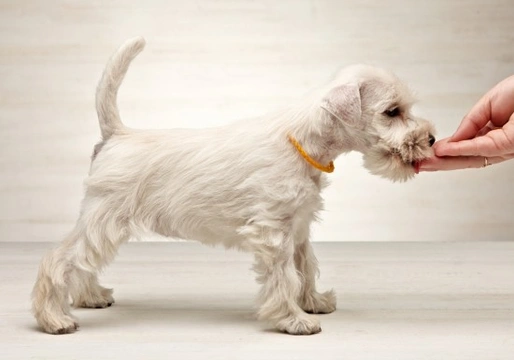
Some more information on the Miniature Schnauzer
The miniature Schnauzer dog breed is the smallest of the three Schnauzer variants, with the other two being standard and giant. Developed in the 19th century in Germany, the miniature Schnauzer is the result of out crossing the standard Schnauzer with smaller breeds such as the Poodle and the Affenpinscher, to produce a dog with all of the expected Schnauzer traits, but smaller!
They are lively, intelligent dogs that are effective at guarding and protection, despite their small size, and were also previously valued for their skills as rat catchers! Today, the miniature Schnauzer is a very popular dog breed all across the world as one of the larger “small” dog types, with a big personality. If you are looking for a small dog breed but don’t want a typical lapdog, then the miniature Schnauzer might be a good choice.
In this article, we will cover some information on the miniature Schnauzer in more depth, including their personality traits, health and general requirements. Read on to learn more!
What does the miniature Schnauzer look like?
The miniature schnauzer stands 12-14 inches tall at the shoulder, and can be seen in a variety of colours in the silver, black, or salt and pepper spectrum. They can also occasionally be seen in white, but not all breed registries recognise this as a proper colour for dogs of the breed. Their coats are double-layered and wiry, and they have a signature moustache on their faces, and a compact, medium built muscular appearance.
The miniature Schnauzer personality
The Schnauzer comes from the terrier dog grouping, and a lot of their behaviour, temperament and personality is very obviously terrier in origin. They are tenacious, determined, lively and persistent, and can be prone to stubbornness. They are fairly vocal and can fairly be described as “busy” dogs, that like to get involved in everything and are very alert and watchful! They have a relatively strong prey drive too, and may be prone to hunting or stalking smaller animals outside of the home. While they can be kept successfully with other pets such as cats or rabbits, they do need to be properly introduced to them from a young age, and taught not to chase or hunt them!
They make for excellent family dogs providing that they have a mutual respect with any children that live with them, but they do often bond closely with their main caregiver, and respond well to training from one particular person. They are clever and very trainable, but do tend to get bored easily if they do not have enough to do!
While they are small dogs, they are fairly lively and need to be able to play and run around regularly, as well as being walked two to three times a day. They do not need a large home to be happy within it, but they do need a reasonable amount of variety in their lives, and lots of varied walks and other forms of entertainment to be provided.
Miniature Schnauzer health and longevity
The miniature Schnauzer has an average longevity of twelve years, although it is not uncommon for dogs of the breed to live to over fifteen in good health. They are, however, prone to certain health conditions that have a genetic or hereditary aspect to them, which all potential buyers should be aware of.
Eye issues is one of the first potential issues that the miniature Schnauzer might face, with the breed having slightly elevated risk factors for conditions such as entropion, progressive retinal atrophy and cataracts, although cataracts can often be surgically removed to restore good vision.
Kidney and bladder stones are also a potential problem for the miniature Schnauzer, and in fact they are the breed that is most likely to suffer from such problems. Other potential health problems that appear to present in miniature Schnauzers more than most other breeds include hypothyroidism, and pancreatitis. Pancreatitis in particular can be fast to develop and very serious, so all potential miniature Schnauzer owners should make themselves aware of the symptoms of the condition and be alert to its possible development.
Grooming a miniature Schnauzer
Part of the Schnauzer’s distinctive appearance comes thanks to its heavy eyebrows and pronounced beard, making them instantly recognisable whatever their size! Their coats require a reasonable amount of brushing and grooming, and it is also very popular to have the coat of the miniature Schnauzer clipped off on a regular basis to keep it neat and easier to manage.
Un-clipped hair will grow to up to four inches long, making it in need of daily brushing, while a standard Schnauzer clip will remove most of the longer hair on the body, while leaving a signature fringe on the belly and legs, and trimming and tidying up the hair around the face and ensuring that the dog can see out!



